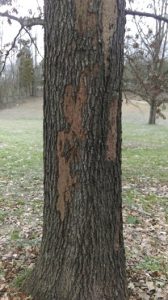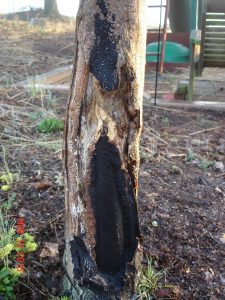Question & Answer
Common culprits of tree damage
Q. This is a very beautiful large tree that I lost last year. It’s the second one I have lost in the past seven years. Would you be able to see from the photo what might be happening to my trees? I have more beautiful trees on my property that I would like to save if I can. – L.P., Elizabeth, Indiana
A. While I can’t be certain from this photo, from the pattern of the remaining bark I wonder if this might be an ash tree. If so, a prime suspect would be the emerald ash borer, a serious and fatal pest of ash trees throughout most of Indiana, including your county. If you have additional ash trees, you’ll need to assess their health and decide whether the remaining trees are healthy and valuable enough to invest in protecting them. Purdue Entomology has an excellent website that will help you identify both the ash trees as well as the emerald ash borer and walk you through the decision making steps for managing the problem. https://extension.entm.purdue.edu/EAB/index.php?
page=management/homeowners
You might also contact your Harrison County office of Purdue Extension for additional information and assistance in identifying the problem. https://extension.purdue.edu/Harrison/pages/aboutus.aspx
Q. Our beautiful yellow “butterfly” magnolia tree is losing bark at the base area of tree. I was desperate and sprayed tree spray, but it appears to be going up the tree. Can you please tell us what is damaging this tree? – E.L., Holland, Indiana
A. It is difficult to determine the initial cause of the injury to the lower trunk, but there are several common culprits. The thin bark on young trees can be susceptible to what is termed “frost cracking” – a splitting of the bark as a result of rapid temperature changes during cold, but sunny winter days. The thin outer bark expands in the heat of the sun, but rapidly contracts as the temperature drops at sundown. The bark contracts faster than the inner wood resulting in split bark. This splitting of the bark is also known as “southwest injury” since it is most likely to occur on the southwest facing side of the trunk. Another possibility is mechanical injury caused by “mower or weed whip blight” when these machines get too close to the trunk and knock off pieces of bark. Rodents and rabbits can cause similar injury when they feed on the tender young bark of trees.
Spraying the trunk will not help, and most tree experts feel that the tar-based sprays and other wound dressings actually interfere with the natural wound closure process in trees. Unfortunately, there just isn’t much you can do after trunk injury occurs. Trees can survive for many years with such injury, but it is always a potential for disease, insect pests and decay to cause further injury. Purdue Forestry has an excellent publication discussing mechanical injury to trees, especially on how to prevent such injury. https://www.extension.purdue.edu/extmedia/fnr/fnr-492-w.pdf

